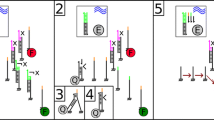Abstract
DNA computing has the potential to create powerful devices, but, in the context of well-mixed systems, sequentiality of operations is hard to achieve. To enforce such sequentiality, we propose a generic delay gate that can be interfaced with virtually any DNA system. Since it is system-independent, our delay gate can be used as an off-the-shelf library to accelerate the design of increasingly complex systems. Additionally, we checked the feasibility of our design by testing various in vitro implementations. We also present a theoretical proof of concept of its applicability by using it to complement an existing DNA module library, the DNA toolbox, to design new systems.













Similar content being viewed by others
References
Benenson Y, Gil B, Ben-Dor U, Adar R, Shapiro E (2004) An autonomous molecular computer for logical control of gene expression. Nature 429(6990):423–429
Condon A, Hu AJ, Maňuch J, Thachuk C (2012) Less haste, less waste: on recycling and its limits in strand displacement systems. Interface Focus 2(4):512–521
Fujii T, Rondelez Y (2012) Predator–prey molecular ecosystems. ACS Nano 7(1):27–34
Genot AJ, Zhang DY, Bath J, Turberfield AJ (2011) Remote toehold: a mechanism for flexible control of DNA hybridization kinetics. J Am Chem Soc 133(7):2177–2182
Genot AJ, Fujii T, Rondelez Y (2012) Computing with competition in biochemical networks. Phys Rev Lett 109(20):208102
Genot AJ, Fujii T, Rondelez Y (2013) Scaling down DNA circuits with competitive neural networks. J R Soc Interface 10(85):20130212
Hagiya M, Arita M, Kiga D, Sakamoto K, Yokoyama S (1999) Towards parallel evaluation and learning of boolean-formulas with molecules, vol. 48. DNA based computers III, DIMACS series in discrete mathematics and theoretical computer science. pp 57–72
Koshkin AA, Singh SK, Nielsen P, Rajwanshi VK, Kumar R, Meldgaard M, Wengel J (1998) LNA (locked nucleic acids): synthesis of the adenine, cytosine, guanine, 5-methylcytosine, thymine and uracil bicyclonucleoside monomers, oligomerisation, and unprecedented nucleic acid recognition. Tetrahedron 54(14):3607–3630
Lamport L (1977a) Concurrent reading and writing. Commun ACM 20(11):806–811
Lamport L (1977b) Proving the correctness of multiprocess programs. IEEE Trans Softw Eng 3(2):125–143
Montagne K, Plasson R, Sakai Y, Fujii T, Rondelez Y (2011a) Programming an in vitro DNA oscillator using a molecular networking strategy. Mol Syst Biol 7(1):466
Montagne K, Plasson R, Padirac A, Fujii F, Rondelez Y (2011b) A toolbox to build time-responsive in vitro DNA networks. In: Oral presentation, 17th international conference of DNA computing and molecular programming
Padirac A, Fujii T, Rondelez Y (2012a) Quencher-free multiplexed monitoring of DNA reaction circuits. Nucleic Acids Res 40(15):e118
Padirac A, Fujii T, Rondelez Y (2012b) Bottom-up construction of in vitro switchable memories. Proc Natl Acad Sci 109(47):E3212–E3220
Pei R, Matamoros E, Liu M, Stefanovic D, Stojanovic MN (2010) Training a molecular automaton to play a game. Nat Nanotechnol 5(11):773–777
Qian L, Winfree E (2011) Scaling up digital circuit computation with DNA strand displacement cascades. Science 332(6034):1196–1201
Soloveichik D, Seelig G, Winfree E (2010) DNA as a universal substrate for chemical kinetics. Proc Natl Acad Sci 107(12):5393–5398
Thachuk C, Condon A (2012) Space and energy efficient computation with DNA strand displacement systems, vol. 7433. In: DNA computing and molecular programming. Lecture notes in computer science. pp 135–149
Whitcombe D, Theaker J, Guy SP, Brown T, Little S (1999) Detection of PCR products using self-probing amplicons and fluorescence. Nat Biotechnol 17:804–807
Zhang DY, Winfree E (2009) Control of DNA strand displacement kinetics using toehold exchange. J Am Chem Soc 131(47):17303–17314
Author information
Authors and Affiliations
Corresponding author
Rights and permissions
About this article
Cite this article
Aubert, N., Rondelez, Y., Fujii, T. et al. Enforcing logical delays in DNA computing systems. Nat Comput 13, 559–572 (2014). https://doi.org/10.1007/s11047-014-9450-9
Published:
Issue Date:
DOI: https://doi.org/10.1007/s11047-014-9450-9




